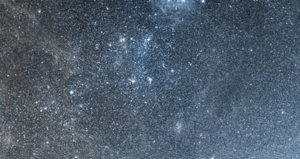Astronomy:IRAS 05280-6910
| Observation data Equinox J2000.0]] (ICRS) | |
|---|---|
| Constellation | Dorado (LMC) |
| Right ascension | 05h 28m 00.28s[1] |
| Declination | −69° 10′ 26.0″[1] |
| Characteristics | |
| Apparent magnitude (J) | 14.45[2] |
| Apparent magnitude (K) | 12.87[2] |
| Details | |
| Radius | 1,367[3] - 1,736[4][lower-alpha 1] R☉ |
| Luminosity | 220,000[4] - 225,000[3] L☉ |
| Temperature | 3,000[4] - 3,400[3] K |
| Other designations | |
IRAS 05280-6910, MSX LMC 582, OH 279.6 -32.6, LI-LMC 1100, NGC 1984 IR 1 | |
| Database references | |
| SIMBAD | data |
IRAS 05280-6910 is a red supergiant star or OH/IR supergiant star[5] located in the Large Magellanic Cloud. Its radius is calculated to be more than a thousand times that of the Sun, making it one of the largest stars discovered so far. If placed at the center of the Solar System, its photosphere would engulf the orbit of Jupiter. It has an estimated mass loss rate of 5.4×10−4 M☉ per year, one of the highest known for any red supergiant star.[3]
Characteristics
IRAS 05280-6910 is likely an OH supergiant star. It is the most reddened object in the LMC, far exceeding the redness of the famous dust enshrouded red supergiant WOH G64. It also shows the distinct type of maser signal similar to that of VY Canis Majoris.[6] Its exact radius is uncertain. According to one paper, it is 1,367 times the size of the Sun,[3] while another says that it is 1,736 times the size of the Sun. In either case, it is among the largest stars known.[4]
IRAS 05280-6910 likely had a mass of 20 to 25 solar masses when it formed.[6]
See also
Notes
- ↑
The radius of IRAS 05280-6910 can be calculated using the Stefan–Boltzmann law and the solar effective temperature of 5,772 K:
References
- ↑ 1.0 1.1 Gruendl, R.A.; Chu, Y.-H. (2009). "High- and intermediate-mass young stellar objects in the Large Magellanic Cloud.". The Astrophysical Journal Supplement 184 (1): 172–197. doi:10.1088/0067-0049/184/1/172. Bibcode: 2009ApJS..184..172G.
- ↑ 2.0 2.1 Van Loon, J.T.; Marshall, J.R.; Zijlstra, A. A. (2005). "Dust-enshrouded giants in clusters in the Magellanic Clouds.". Astronomy and Astrophysics 442 (2): 597–613. doi:10.1051/0004-6361:20053528. Bibcode: 2005A&A...442..597V.
- ↑ 3.0 3.1 3.2 3.3 3.4 Steven R. Goldman; Jacco Th. van Loon (2016). "The wind speeds, dust content, and mass-loss rates of evolved AGB and RSG stars at varying metallicity". Monthly Notices of the Royal Astronomical Society 465 (1): 403–433. doi:10.1093/mnras/stw2708. Bibcode: 2017MNRAS.465..403G.
- ↑ 4.0 4.1 4.2 4.3 Matsuura, Mikako; Sargent, B.; Swinyard, Bruce; Yates, Jeremy; Royer, P.; Barlow, M. J.; Boyer, Martha; Decin, L. et al. (2016). "The mass-loss rates of red supergiants at low metallicity: Detection of rotational CO emission from two red supergiants in the Large Magellanic Cloud". Monthly Notices of the Royal Astronomical Society 462 (3): 2995–3005. doi:10.1093/mnras/stw1853. Bibcode: 2016MNRAS.462.2995M.
- ↑ Wood, P. R.; Whiteoak, J. B.; Hughes, S. M. G.; Bessell, M. S.; Gardner, F. F.; Hyland, A. R. (October 1992). "OH/IR Stars in the Magellanic Clouds" (in en). The Astrophysical Journal 397: 552. doi:10.1086/171812. ISSN 0004-637X. Bibcode: 1992ApJ...397..552W.
- ↑ 6.0 6.1 Beasor, Emma R.; Smith, Nathan (May 2022). "The extreme scarcity of dust-enshrouded red supergiants: consequences for producing stripped stars via winds". arXiv:2205.02207 [astro-ph.SR].


